The wooden Tserkva of Dormition of the Mother of God in Zadąbrowie was built in 1660 (according to some sources in 1584). It was a filial tserkva of the parish in Święte, and earlier of the parish in Radymno.
After 1947 the building functioned as a Roman Catholic church. In 1984 the tserkva was moved 50 metres eastward, and a new brick church was built at its location. In 2011 works were initiated to move the tserkva to the cemetery, to be used as a pre-funeral chapel.
During reconstruction in the 19th century the structure of the ceilings and roofs was altered. The log church is oriented eastward. The nave and the narthex have square floor plan and are covered with two-pitched roofs, while the chancel - enclosed with semi-hexagonal walls - has a five-pitched roof. All the roofs are clad with sheet metal. Over the nave we can see an onion-shaped bell turret topped with an iron cross. A similar cross can be seen on top of the roof of the narthex. The whole building is covered with vertical wood planks. A two-tier cornice runs along the walls below the roof. In the corners and in the middle of the nave walls there are ornamental wooden pilasters. The gable end of the nave holds an enshrined sculpture of the Holy Mother with the date 1934.
Inside there are flat ceilings. No original features have been preserved, except for parts of figural and ornamental wall paintings and two side altars, with Archangel Michael the Archistrategos (to the right) and St. Nicholas the Wonderworker (to the left). The furnishings also include two procession floats with folk-style representation of Archangel Michael, a kivot and parts of an iconostasis. An 18th century icon, and part of a 17th century icon, as well as a tserkva banner and candlesticks were found during conservation works.
Next to the tserkva we can see a lapidarium comprising old tombstones. Until recently there was also a wooden belfry from the 1800s.
Photo: Magdalena Bodzek
Gallery
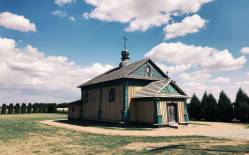
Recommended venues on the Trail
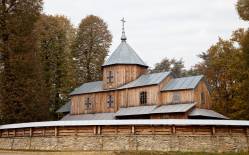
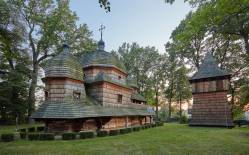
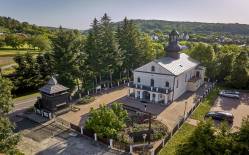
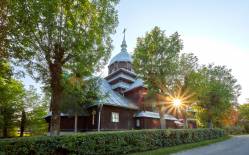



This website has been modernized with the financial support of the European Union under the Cross-Border Cooperation Programme Poland-Belarus-Ukraine 2014-2020. The responsibility for its content lies solely with the Podkarpackie Regional Tourism Board and cannot, in any case, be treated as a reflection of the position of the European Union, the Managing Authority, or the Joint Technical Secretariat of the Cross-Border Cooperation Programme Poland-Belarus-Ukraine 2014-2020.









